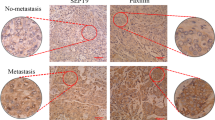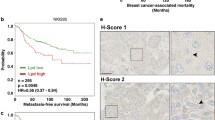Abstract
The Ste20-like kinase, SLK, is involved in the control of cell motility through its effects on actin reorganization and focal adhesion turnover. Here we investigated the role of SLK in chemotaxis downstream of the tyrosine kinase receptor, HER2/ErbB2/Neu, which is frequently overexpressed in human breast cancers. Our results show that SLK is required for the efficient cell migration of human and mouse mammary epithelial cell lines in the presence of the Neu activator, heregulin, as a chemoattractant. SLK activity is stimulated by heregulin treatment or by overexpression of activated Neu. Phosphorylation of tyrosine 1201 or tyrosines 1226/7 on Neu is a key event for SLK activation and cell migration, and cancer cell invasion mediated by these tyrosines is inhibited by kinase-inactive SLK. Signaling pathway inhibitors show that Neu-mediated SLK activation is dependent on MEK, PI3K, PLCγ and Shc signaling. Furthermore, heregulin-stimulated SLK activity requires signals from the focal adhesion proteins, FAK and src. Finally, phospho-FAK analysis shows that SLK is required for Neu-dependent focal adhesion turnover. Together, these studies define an interaction between Neu and SLK signaling in the regulation of cancer cell motility.







Similar content being viewed by others
References
Beerli RR, Wels W, Hynes NE . (1994). Intracellular expression of single chain antibodies reverts ErbB-2 transformation. J Biol Chem 269: 23931–23936.
Benlimame N, He Q, Jie S, Xiao D, Xu YJ, Loignon M et al. (2005). FAK signaling is critical for ErbB-2/ErbB-3 receptor cooperation for oncogenic transformation and invasion. J Cell Biol 171: 505–516.
Broussard JA, Webb DJ, Kaverina I . (2008). Asymmetric focal adhesion disassembly in motile cells. Curr Opin Cell Biol 20: 85–90.
Burakov AV, Zhapparova ON, Kovalenko OV, Zinovkina LA, Potekhina ES, Shanina NA et al. (2008). Ste20-related protein kinase LOSK (SLK) controls microtubule radial array in interphase. Mol Biol Cell 19: 1952–1961.
Cook TA, Nagasaki T, Gundersen GG . (1998). Rho guanosine triphosphatase mediates the selective stabilization of microtubules induced by lysophosphatidic acid. J Cell Biol 141: 175–185.
Dankort D, Jeyabalan N, Jones N, Dumont DJ, Muller WJ . (2001a). Multiple ErbB-2/Neu phosphorylation sites mediate transformation through distinct effector proteins. J Biol Chem 276: 38921–38928.
Dankort D, Maslikowski B, Warner N, Kanno N, Kim H, Wang Z et al. (2001b). Grb2 and Shc adapter proteins play distinct roles in Neu (ErbB-2)-induced mammary tumorigenesis: implications for human breast cancer. Mol Cell Biol 21: 1540–1551.
Dankort DL, Muller WJ . (1996). Transgenic models of breast cancer metastasis. Cancer Treat Res 83: 71–88.
Dankort DL, Muller WJ . (2000). Signal transduction in mammary tumorigenesis: a transgenic perspective. Oncogene 19: 1038–1044.
Dankort DL, Wang Z, Blackmore V, Moran MF, Muller WJ . (1997). Distinct tyrosine autophosphorylation sites negatively and positively modulate neu-mediated transformation. Mol Cell Biol 17: 5410–5425.
Ellinger-Ziegelbauer H, Karasuyama H, Yamada E, Tsujikawa K, Todokoro K, Nishida E . (2000). Ste20-like kinase (SLK), a regulatory kinase for polo-like kinase (Plk) during the G2/M transition in somatic cells. Genes Cells 5: 491–498.
Frame MC . (2004). Newest findings on the oldest oncogene; how activated src does it. J Cell Sci 117: 989–998.
Guy CT, Webster MA, Schaller M, Parsons TJ, Cardiff RD, Muller WJ . (1992). Expression of the neu protooncogene in the mammary epithelium of transgenic mice induces metastatic disease. Proc Natl Acad Sci USA 89: 10578–10582.
Hamadi A, Bouali M, Dontenwill M, Stoeckel H, Takeda K, Ronde P . (2005). Regulation of focal adhesion dynamics and disassembly by phosphorylation of FAK at tyrosine 397. J Cell Sci 118: 4415–4425.
Hauck CR, Hsia DA, Schlaepfer DD . (2000). Focal adhesion kinase facilitates platelet-derived growth factor-BB-stimulated ERK2 activation required for chemotaxis migration of vascular smooth muscle cells. J Biol Chem 275: 41092–41099.
Hauck CR, Sieg DJ, Hsia DA, Loftus JC, Gaarde WA, Monia BP et al. (2001). Inhibition of focal adhesion kinase expression or activity disrupts epidermal growth factor-stimulated signaling promoting the migration of invasive human carcinoma cells. Cancer Res 61: 7079–7090.
Holbro T, Civenni G, Hynes NE . (2003). The ErbB receptors and their role in cancer progression. Exp Cell Res 284: 99–110.
Holbro T, Hynes NE . (2004). ErbB receptors: directing key signaling networks throughout life. Annu Rev Pharmacol Toxicol 44: 195–217.
Hynes NE, Lane HA . (2005). ERBB receptors and cancer: the complexity of targeted inhibitors. Nat Rev Cancer 5: 341–354.
Itoh S, Kameda Y, Yamada E, Tsujikawa K, Mimura T, Kohama Y . (1997). Molecular cloning and characterization of a novel putative STE20-like kinase in guinea pigs. Arch Biochem Biophys 340: 201–207.
Khoury H, Dankort DL, Sadekova S, Naujokas MA, Muller WJ, Park M . (2001). Distinct tyrosine autophosphorylation sites mediate induction of epithelial mesenchymal like transition by an activated ErbB-2/Neu receptor. Oncogene 20: 788–799.
Kuramochi S, Moriguchi T, Kuida K, Endo J, Semba K, Nishida E et al. (1997). LOK is a novel mouse STE20-like protein kinase that is expressed predominantly in lymphocytes. J Biol Chem 272: 22679–22684.
Lahlou H, Sanguin-Gendreau V, Zuo D, Cardiff RD, McLean GW, Frame MC et al. (2007). Mammary epithelial-specific disruption of the focal adhesion kinase blocks mammary tumor progression. Proc Natl Acad Sci USA 104: 20302–20307.
Mansour EG, Ravdin PM, Dressler L . (1994). Prognostic factors in early breast carcinoma. Cancer 74: 381–400.
Marone R, Hess D, Dankort D, Muller WJ, Hynes NE, Badache A . (2004). Memo mediates ErbB2-driven cell motility. Nat Cell Biol 6: 515–522.
Mitra SK, Schlaepfer DD . (2006). Integrin-regulated FAK–Src signaling in normal and cancer cells. Curr Opin Cell Biol 18: 516–523.
Northey JJ, Chmielecki J, Ngan E, Russo C, Annis MG, Muller WJ et al. (2008). Signaling through ShcA is required for transforming growth factor beta- and Neu/ErbB-2-induced breast cancer cell motility and invasion. Mol Cell Biol 28: 3162–3176.
O'Reilly PG, Wagner S, Franks DJ, Cailliau K, Browaeys E, Dissous C et al. (2005). The Ste20-like kinase SLK is required for cell cycle progression through G2. J Biol Chem 280: 42383–42390.
Palazzo AF, Cook TA, Alberts AS, Gundersen GG . (2001). mDia mediates Rho-regulated formation and orientation of stable microtubules. Nat Cell Biol 3: 723–729.
Palazzo AF, Gundersen GG . (2002). Microtubule-actin cross-talk at focal adhesions. Sci STKE 2002: PE31.
Pytowski B, Hicklin DJ, Kornhaber G, Dellaratta DV, Witte L . (1998). Identification and initial characterization of mSLK, a murine member of the STE20 family of kinases. Arch Biochem Biophys 359: 310–319.
Sabourin LA, Rudnicki MA . (1999). Induction of apoptosis by SLK, a Ste20-related kinase. Oncogene 18: 7566–7575.
Sabourin LA, Tamai K, Seale P, Wagner J, Rudnicki MA . (2000). Caspase 3 cleavage of the Ste20-related kinase SLK releases and activates an apoptosis-inducing kinase domain and an actin-disassembling region. Mol Cell Biol 20: 684–696.
Sieg DJ, Hauck CR, Ilic D, Klingbeil CK, Schaefer E, Damsky CH et al. (2000). FAK integrates growth-factor and integrin signals to promote cell migration. Nat Cell Biol 2: 249–256.
Siegel PM, Dankort DL, Muller WJ . (2000). Oncogene mediated signal transduction in transgenic mouse models of human breast cancer. Adv Exp Med Biol 480: 185–194.
Siesser PM, Meenderink LM, Ryzhova L, Michael KE, Dumbauld DW, Garcia AJ et al. (2008). A FAK/Src chimera with gain-of-function properties promotes formation of large peripheral adhesions associated with dynamic actin assembly. Cell Motil Cytoskeleton 65: 25–39.
Wagner S, Flood TA, O'Reilly P, Hume K, Sabourin LA . (2002). Association of the Ste20-like kinase (SLK) with the microtubule. Role in Rac1-mediated regulation of actin dynamics during cell adhesion and spreading. J Biol Chem 277: 37685–37692.
Wagner S, Storbeck CJ, Roovers K, Chaar ZY, Kolodziej P, McKay M et al. (2008). FAK/src-family dependent activation of the Ste20-like kinase SLK is required for microtubule-dependent focal adhesion turnover and cell migration. PLoS ONE 3: e1868.
Webb DJ, Donais K, Whitmore LA, Thomas SM, Turner CE, Parsons JT et al. (2004). FAK–Src signalling through paxillin, ERK and MLCK regulates adhesion disassembly. Nat Cell Biol 6: 154–161.
Webb DJ, Parsons JT, Horwitz AF . (2002). Adhesion assembly, disassembly and turnover in migrating cells—over and over and over again. Nat Cell Biol 4: E97–E100.
Yamada E, Tsujikawa K, Itoh S, Kameda Y, Kohama Y, Yamamoto H . (2000). Molecular cloning and characterization of a novel human STE20-like kinase, hSLK. Biochim Biophys Acta 1495: 250–262.
Zhang Y-H, Hume K, Cadonic R, Thompson C, Staines W, Hakim A et al. (2002). Expression of the Ste20-like kinase SLK during embryonic development and in the murine adult central nervous system. Brain Res Dev Brain Res 139: 205–215.
Acknowledgements
This work was supported by the Canadian Breast Cancer Foundation, the Canadian Institute for Health Research and a Premier's Research for Excellence Award. KR is supported by the Canadian Breast Cancer Foundation, SW is supported by OGSST and NSERC studentships and CJS is the recipient of a Canadian Heart and Stroke Foundation Fellowship. PMS is a research scientist of the National Cancer Institute of Canada and LAS is the recipient of a CIHR scholar award.
Author information
Authors and Affiliations
Corresponding author
Rights and permissions
About this article
Cite this article
Roovers, K., Wagner, S., Storbeck, C. et al. The Ste20-like kinase SLK is required for ErbB2-driven breast cancer cell motility. Oncogene 28, 2839–2848 (2009). https://doi.org/10.1038/onc.2009.146
Received:
Revised:
Accepted:
Published:
Issue Date:
DOI: https://doi.org/10.1038/onc.2009.146
- Springer Nature Limited
Keywords
This article is cited by
-
AKT-mediated phosphorylation of Sox9 induces Sox10 transcription in a murine model of HER2-positive breast cancer
Breast Cancer Research (2021)
-
Loss of the Ste20-like kinase induces a basal/stem-like phenotype in HER2-positive breast cancers
Oncogene (2020)
-
The RNA-binding protein Rbfox2: an essential regulator of EMT-driven alternative splicing and a mediator of cellular invasion
Oncogene (2014)
-
Activation of diverse signalling pathways by oncogenic PIK3CA mutations
Nature Communications (2014)
-
Distinct roles for Ste20-like kinase SLK in muscle function and regeneration
Skeletal Muscle (2013)




